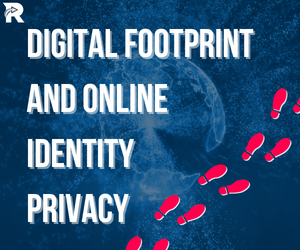
One of the most precious resources for hackers can be the information one puts on the internet themselves. Threat actors can utilize your digital footprint to target you for cyber attack. So, how can one minimize their digital footprint and protect themselves from cyber crime?
“Whenever you use the internet, you leave behind a trail of information known as your digital footprint. A digital footprint grows in many ways – for example, posting on social media, subscribing to a newsletter, leaving an online review, or shopping online. Sometimes, it’s not always obvious that you are contributing to your digital footprint. For example, websites can track your activity by installing cookies on your device, and apps can collate your data without you knowing it. Once you allow an organization to access your information, they could sell or share your data with third parties. Worse still, your personal information could be compromised as part of a data breach.” (Kaspersky).
Data breaches can reveal a multitude of personal and valuable information about you. It can be difficult but, there are ways to monitor, track, and minimize your footprint to prevent data breaches.
“But for most of our information, once it's out there on the internet, it's out there for good and there's not much we can do about it. That means the best practice is to understand what information might be out there and to be alert about when your personal data might potentially be abused.” (ZD Net). “If there's old accounts that you don't use anymore, it might be worth shutting them down, as they could contain a lot of personal information that could be used against you by cyber criminals. If the account doesn't exist, there's much less risk to the user.”
There are two types of digital footprints, active, where you put out purposefully on your own, and passive, where you don’t.
“A passive digital footprint is created when information is collected about the user without them being aware that this is happening. For example, this occurs when websites collect information about how many times users visit, where they come from, and their IP address. This is a hidden process, which users may not realize is taking place. Other examples of passive footprints include social networking sites and advertisers using your likes, shares, and comments to profile you and target you with specific content.” (Kaspersky).
You can monitor the use of your name with this strategy.
“Enter your name into search engines. Include your first and last name and any variations on spellings. If you have changed your name, search for both current and former names. Reviewing the search engine results will give you a sense of what information about you is publicly available. If any of the results show you in a negative light, you could contact the site administrator to see if they can remove it. Setting up Google Alerts is one way to keep an eye on your name.” (Kaspersky).
Have any questions about cyber-security? Responsive Technology Partners is the leading cyber-security expert in the Athens, Metter, Milledgeville, Vidalia, and Atlanta, Georgia areas. We also have locations in Tampa, Florida, Roanoke, Virginia, and Raleigh South Carolina. Service offerings include I.T. support, cyber-security and compliance, telephony, cloud services, cabling, access control, and camera systems. Our company’s mission is to provide world-class customer service through industry leading I.T. solutions that make every customer feel as if they are our only customer. Please visit our website to learn more: https://www.responsivetechnologypartners.com/.
Sources:
Kaspersky. https://www.kaspersky.com/resource-center/definitions/what-is-a-digital-footprint




